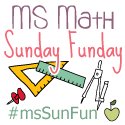
In a recent PLC meeting, our algebra team talked about how we were each practicing specific skills. The scores on our last common quiz were abysmal and depressing! I've determined that in my classes we need to do more routine practice and yet ... it won't work to just do one workbook page after another. So I'm glad our Sunday Funday topic is on practice! I look forward to learning from my colleagues!
I find that practicing skills in pairs typically works best. I like self-checking activities. So one activity I am using this coming week on solving inequalities is the Inequality Match ups. Students may choose to solve the inequalities independently or with a partner. They have to show their work, and create a grid of answers. They will check their grid against my answer key.
I don't have a sample handy for this second idea ... but we practice in pairs. Each partner has a separate set of problems. The problems are designed so that the solutions to each partner's corresponding problem are the same. So they can check their work against one another easily.
A third method of practicing I've used is the Four Sum Solving Equations. This worked well when we were solving equations. Students work in in pairs or small groups. I gave them just 4 equations at a time and told them that if their solutions were correct, the sum of the solutions would be a specific value.
Last, I've used a circuit like Equation Circuit or loop practice twice in these first weeks of school. It gets a little chaotic in the room but students work in small teams to complete the loop.
Getting all students to complete all of the practice has been a challenge. I expect all students to do all of the work and I'm working on motivation ideas to ensure that they do. I don't want to take up all the work but the threat of a grade is all that will motivate some to complete the work. Many will also work for points or Jolly Ranchers. I'm curious how others hold all students accountable for the practice?!?
[...] Beth, Pairs & Self-Checking [...]
ReplyDeleteWould you give a full explanation of how the Equation Cirut works? I've never done something like this before.
ReplyDeleteHi - glad to.
ReplyDeleteCreate 12 posters ... I just use copy paper. Write each problem in the middle of each paper and label each equation with the label letter. In one corner of each poster write an answer to one of the other equations. So ... on poster A, write the equation, x - 9 = - 23. Notice the solution to that equation is on poster H. So each poster has a problem on it ... and the answer to another problem in the room. Poster A has the answer to poster I.
Hang the posters around your room. Create student teams or groups, assign each one to start at any of the 12 posters. As students work one equation, they find the answer to that equation on another poster. They write down that letter. And then work the second equation ... and go find the answer to the second problem.
At the end students will have worked all 12 problems. Their answers to the circuit will all be the same loop of letters.
Hope that helps.